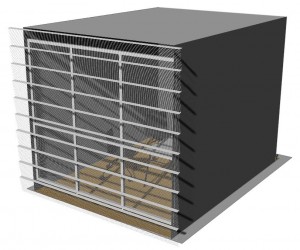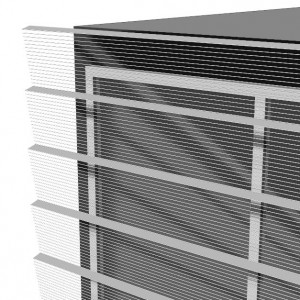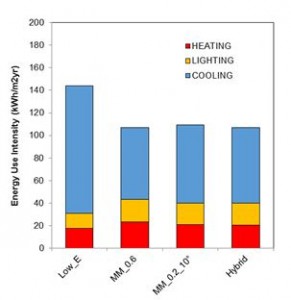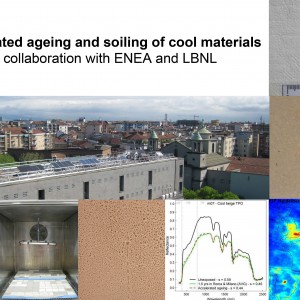Our Paper presented at Advanced Building Skin – Energy Forum in Bern.
Windows are the most important component within building envelope to control both solar heat gain and thermal losses, but also to guarantee an optimal daylight level.
Metal mesh are used in new and renovated buildings, especially in office building, as an external second envelope skin to enhance architecture design, to manage daylight levels and to control solar gains.
The aim is the optimization of their position, compared to the façade raising plane, enhancing the metal mesh systems energy performance, increasing the comfort requirements and reducing the amount of used material to minimize costs.
In order to evaluate their performances (mesh spacing and orientation) an estimation of the primary energy consumption for heating, cooling, lighting and daylight comfort has been carried out. The study case is a single 3 x 4 x 3m (W x L x H) office unit placed in Milan (Italy) under a single orientation (South). It has one wall facing outdoors, having a Window Wall Ratio (WWR) of 86%, and five surfaces, considered as adiabatic, because facing other internal offices (three wall, ceiling and floor).
A three-step approach was carried out to assess a sensitivity analysis with Energy Plus and Radiance engine, managed with a parametric modelling approach (Rhinoceros and Grasshopper), evaluating shading systems performance. For all of the simulations have been calculated the total primary energy (for heating, cooling and lighting) and the principle daylight comfort index like (Daylight Factor, Useful daylight illuminance and Glare Analysis). In the first step the standard metal mesh system with different ratio between spacing and characteristic diameter (d/D equal to 0.2, 0.6, 1) has been analysed and compared with a standard façade solution such as low-e double glazing unit (DGU) alone and the same one coupled with an internal curtain.


In a second phase the performance of metal mesh shading device with different tilt angle (-20°, -10°, 10°) were evaluated. In the third phase, a further system implementation was assessed decomposing the second phase system in smaller sub-systems using a hybrid solution with metal mesh and louvers.
The results shows that considering only the total energy primary energy use the system that performs better is the metal mesh with d/D equal to 0.6 and a 10° tilt angle (from the façade raising plane). Instead evaluating also costs and internal comfort the hybrid system have a better behaviour.

Authors: Andrea G. Mainini, Andrea Zani, Alberto Speroni, Giovanni Avantaggiato
Link: http://abs.green/program-2015/





Recent Comments